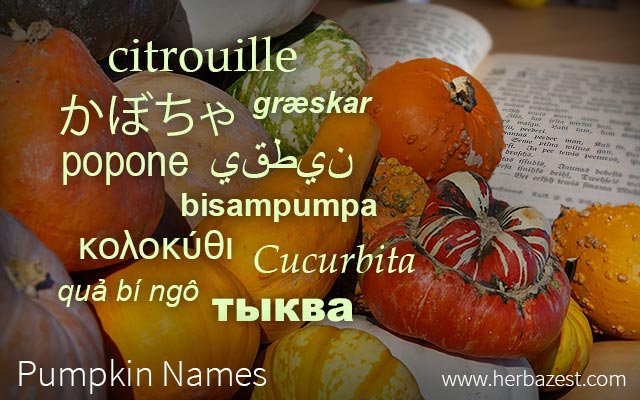The name pumpkin is derived from the Greek word pepon, which means large melon. The word was adapted by the French as pompon, and later changed to pumpion by the English. By the late 17th century, English-speaking immigrants in the New World started pronouncing it as pumpkin, which remains the standard pronunciation to this day.1
Pumpkin generally refers to any round, orange squash that is commonly used for jack-o-lanterns and pumpkin pie. In the U.S., the term pumpkin can be a bit of a misnomer as it places the emphasis on color, but not the botanical makeup of the plant. Native to parts of Central or South America, pumpkins are squashes that are a part of the gourd family, and they have become a popular culinary staple all over the world.
Like all other plants, pumpkins are assigned a botanical name after being classified into specific plant families and species according to their characteristics. The Latin name for pumpkin is Cucurbita pepo. Furthermore, other names for pumpkin exist in the marketplace, where different cultivars are referred to by their commercial names, such as 'Big Tom,' 'Jack Be Little,' 'Baby Boo,' 'Autumn Gold,' 'Jumpin' Jack,' and 'Sweetie Pie.'
Pumpkin Names Around the World
For thousands of years, pumpkins have been cultivated for nourishment, decoration, and therapeutic purposes. A common dietary staple during ancient times, the pumpkin has witnessed a culinary resurgence in recent years, which has piqued the interest of many consumers worldwide who could benefit from knowing the other names for pumpkin across the globe. The following are among the most popular pumpkin names around the world:
Afrikaans name: pampoen
Arabic names: qar' miskî , qar'miski, qara' sudani, qar'ah yábisah
Chinese names: nan gua, nam gua, fan gua, fan kua, jin dong gua, zhong guo
Czech name: tykev pimová
Danish names: centnergræskar, kroghals, krumhalsgréskar, moskusgréskar
Dutch names: pompoen, reuzenkalebas
English names: pumpkin, squash, summer squash, winter squash, ornamental gourd
Finnish name: jättiläiskurpitsa
French names: citrouille, potiron, potimarron, pompon, courge (gourde), courgette, giromons (giraumon/giraumont), calabasse, patisson
Gaelic name: peapag
German name: kürbis (kirbiz)
Greek name: pepon
Hebrew name: delaat
Hindi name: vilayati kaddu
Hungarian name: pézsmatök
Italian names: popone, cocuzza, zucca
Japanese names: kabocha, kabotcha
Korean name: hipak
Latin names: Cucurbita, Cucurbita pepo, Cucurbita pepo L., Cucurbita argyrosperma, Cucurbita maxima, Cucurbita moschata
Norwegian name: muskatgraskar
Polish name: dynia piżmowa
Portuguese names: abóbora, jerimum (jerimu, jerumu, jirimu, jirumum, jurumu, gerimum, gurumu, girimu, girumum)
Russian names: tykva, tykva krupnoplodnaja
Slovenian name: mukatna bua
Spanish names: calabaza, tamalayotl
Swedish name: bisampumpa
Tagalog name: kalabasa
Thai names: fak thong, namtao farang
Vietnamese names: bi do, bi ngo
Yoruba name: elegede
There is a plethora of botanical and commercial pumpkin names that exist to describe the same popular fruit. However, despite the complexity of the words used to characterize pumpkin, the one thing that remains clear is that pumpkin, cultivated since ancient times, is an herb of immense culinary importance all over the world.
Sources
- Edible Medicinal And Non-Medicinal Plants, Volume 2, Fruits, pp. 266-268
- Florida Ethnobotany, pp. 251-253
- Growing Chinese Vegetables in Your Own Backyard, p. 40
- Medicinal Plants of the Borderlands, A bilingual resource guide
- Missouri Botanical Garden, Gardening Help FAQs, Horticulture questions and answers
- University of Illinois, Extension Office, Pumpkins and More
- Vegetables of Canada, p. 175
Footnotes:
- University of Missouri. (2013). Pumpkin: A Brief History. Retrieved October 15, 2021 from https://ipm.missouri.edu/meg/2013/10/Pumpkin-A-Brief-History/




